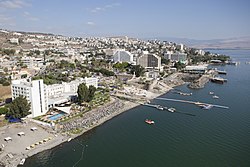提比里亞
来自维基百科,自由的百科全书
提比里亞或太巴列(希伯來語:טְבֶרְיָה,Tveria,Tiveriaⓘ;阿拉伯語:طبرية,Ṭabariyyah;古希臘語:Τιβεριάς,Tiberiás;希臘語:Τιβεριάδα,Tiveriáda;英語:Tiberias,/taɪˈbɪəriəs/)天主教思高聖經譯提庇黎雅,位於以色列北部加利利海畔的下加利利。是以色列的一個古城。和耶路撒冷、采法特和希布倫並列為猶太教四大聖城之一。


提比里亞,建於公元20年,由大希律王的兒子、加利利行省的分封王希律·安提帕斯於拉甲(Rakkat)的廢墟上所建[2][3],並成為加利利行省的省會。「提比里亞」的名字源自當時羅馬帝國的皇帝提庇留。[4]
希律王執政時,猶大行省的猶太人拒絕前往當地定居,認為當地不潔淨,因為當地有一個墳場。17世紀左右,提比里亞被視為是猶太教四大聖城之一。[5]猶太傳統相信彌賽亞在當地崛起[來源請求],而猶太公會亦會在當地復興。
姊妹城市
提比里亞的友好城市有:
參考文獻
外部連結
Wikiwand - on
Seamless Wikipedia browsing. On steroids.


